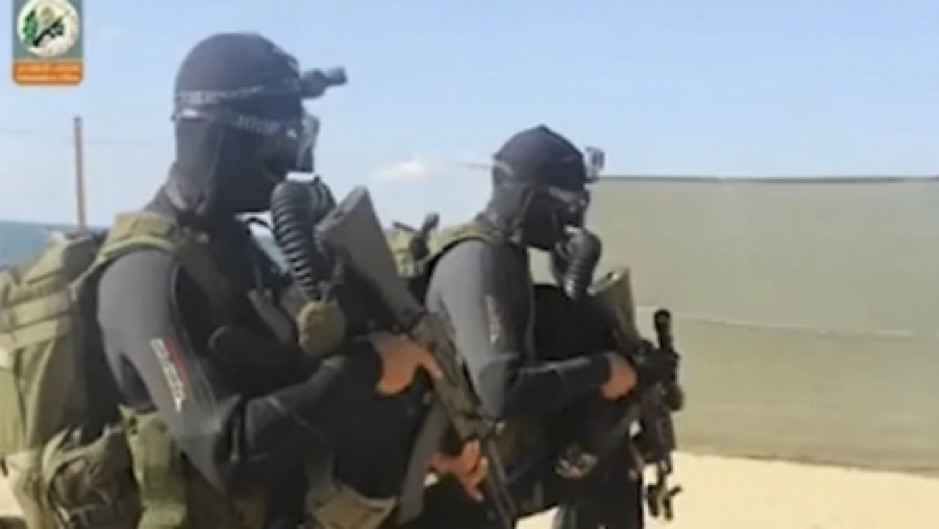FRESH AIR
Terror beneath the sea
June 18, 2018 | Ahron Shapiro and AIJAC Staff

Since its bloody takeover of the Gaza strip in 2007, Hamas has been busy digging. This underground effort was not supposed to ameliorate the lives of the Strip’s two million residents by building infrastructure, expanding irrigation, taking care of sewage or looking for cleaner water sources. No, Hamas has invested huge resources in this project for the sole purpose of building tunnels to be used for terrorism.
Over the years, Hamas created several types of terror tunnels. Often starting inside civilian buildings and regular family houses, attack tunnels were dug in order to get closer to or penetrate Israel, especially IDF military bases surrounding the Gaza strip (such a tunnel was used during Gilad Shalit’s kidnapping in 2006).
Bunker tunnels were dug to be used as headquarters and command centres for Hamas operatives moving undetected inside Gaza. Booby-trapped tunnels were dug with explosives under roads, buildings and strategic locations, designed to ambush the IDF in the event of a future ground incursion. Finally, Hamas dug many smuggling tunnel between Gaza and Egypt, although in recent years, the Egyptian army finally managed to shut down virtually all of them. While they were operating, products, people (terrorists, human trafficking) and weapons were going in and out of Gaza from the Sinai Desert through these tunnels.
The tunnel project represents a massive financial investment for Hamas, particularly when you consider the poor state of Gaza’s economy in general. Many Gazans are employed in digging, fortifying and militarising the tunnels. This employment is long term as these tunnels take a long time to build, especially as the builders are often required to use simple equipment to avoid detection. Stretching kilometres and a hundred metres deep, the structures need air supply and ventilation; communications and lights; and must be protected from rain water. At least 160 Palestinian minors died while constructing tunnels for Hamas, which had exploited their short height and their innocence. When smuggling took place, Hamas collected taxes on smuggled goods, normalising tunnel commerce.
However, the Hamas tunnel destroyed by the Israeli Air Force on June 3 was of a new kind, never encountered before. Firstly, it was a simpler construct, like a pipe. Only 2-3 metres deep and a few dozen metres long, it was built on the Gaza shore three kilometres south of Israel’s border. The opening was inside a building several metres from the sea. From there the tunnel followed an inland path northbound and then turned westward and into the water.

Photo: Hamas’ sea tunnel entry point and compound, which was destroyed by the IAF on June 3.
Another unique characteristic of the sea tunnel was its clientele – Hamas’ naval commandos. This unit includes a few dozen militants from the elite force (‘Nukhba’). They regularly train in the sea, testing their self-produced closed-breathing diving equipment which allows them to swim underwater almost undetected for several kilometres. They also train in sea warfare, beach activity and rocket launching from small sea vehicles. In addition to the elite fighters, there are hundreds of less professional divers in the unit, who can be thrown into battle in case of an all-out conflict. The naval force is deployed at several bases along the Gaza coast where different types of sea vessels are being kept, including speed boats.
Israeli military sources recently revealed that the Iranian funded Islamic Jihad is also developing a naval force in Gaza. Israeli sources believe that the high quality of training and equipment strongly suggests a foreign entity is assisting Hamas’ sea commandos, most likely Iran. Hamas engineer, Mohammed Zawahri, mysteriously killed in Tunisia in December 2016, was also developing unmanned underwater drones for the naval commandos.
The goal of the commandos is to reach Israel from beneath the sea to conduct various terror activities. In July 2014, during the last Gaza war, Hamas naval commandos preformed their most famous attack, when 4-5 divers emerged on the Zikim Beach and started to fire at the Israeli naval base there. Despite being heavily armed with guns, rocket-propelled grenades and explosives, the terrorists were quickly killed by the IDF forces. Another major target for Hamas’ naval commandos is Israel’s strategic sea-based facilities. For example, the gas rigs located off the Ashkelon shores (Yam Tettis, and Tamar), or the power station in southern Ashkelon – only four kilometres north of the Gaza Strip border.
Israel has recently stepped up its effort to tackle the growing threat from Hamas’ naval commandos. During the latest round of attacks in June, the IDF hit at least 30 Hamas naval commando-related targets, including the aforementioned sea tunnel.
Several means have been deployed along the maritime border with Gaza to thwart attacks from the sea. They include underwater sensors, which identify suspicious movements in the water and divers, a physical barrier now being constructed in the shape of a long breakwater between Zikim Beach and the Gaza coast, part of which is underwater, and a wall and a high barbed wire fence along the shore.
The timing for the destruction of the tunnel, which had been under surveillance for a while, was not accidental. By neutralising the tunnel, IDF has foiled a Hamas terror plot in the making.
The plan was that Hamas commandos, dressed in civilian clothes, would enter the building where the tunnel’s opening sits, and change into diving suits, carrying combat gear and weapons. The commandos were then to surreptitiously creep through the tunnel and into the sea, swimming a distance until they reached a point where underwater propulsion devices would be awaiting them. Using these recreational devices co-opted for military purposes, the divers would head north towards Israel, land on the beach during the night and mount a terror attack against Israelis, with the presumption that they would either die during the attack or be captured, as there was no plan to return to Gaza.
Hamas was meticulously concocting this terror plan at the same time it was running the “March of Return” riots over the past few weeks. During these riots, together with terror operatives from other groups – most notably the Iranian-funded Islamic Jihad – Hamas launched ongoing attempts to breach the border, break into Israel and conduct terror. Hamas terrorists disguised in civilian clothes advanced behind women and children, only later to be stopped at the fence by Israeli fire. Almost all Palestinians who were killed during the demonstrations were identified as members of terror organisations. Thousands of kites and balloons carrying incendiary devices and bombs were flown towards neighbouring Israeli fields, burning huge tracts of land, destroying crops and killing numerous animals.
In light of the foiled sea terror plot, the Palestinian story, that the “March of Return” campaign was “peaceful” has been completely exposed, yet again, as mere propaganda, devoid of credibility. The terror tunnel is further proof that portraying Hamas as acting “nonviolently” is nothing more than a lie, constructed to hide the true aim of this group – to terrorise Israel out of existence.
Tags: Hamas, Israel, Palestinians
RELATED ARTICLES

The Government’s actions still fall short: Joel Burnie on FDD Morning Brief

“The writing was on the wall for a number of years”: Colin Rubenstein on Channel 7 Weekend Sunrise





















